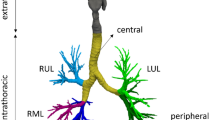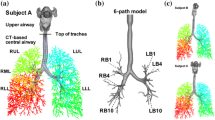Abstract
The effect of carrier gas properties on particle transport in the human lung is investigated numerically in an imaging based airway model. The airway model consists of multi-detector row computed tomography (MDCT)-based upper and intra-thoracic central airways. The large-eddy simulation technique is adopted for simulation of transitional and turbulent flows. The image-registration-derived boundary condition is employed to match regional ventilation of the whole lung. Four different carrier gases of helium (He), a helium–oxygen mixture (He–O2), air, and a xenon–oxygen mixture (Xe–O2) are considered. A steady inspiratory flow rate of 342 mL/s is imposed at the mouthpiece inlet to mimic aerosol delivery on inspiration, resulting in the Reynolds number at the trachea of Re t ≈ 190, 460, 1300, and 2800 for the respective gases of He, He–O2, air, and Xe–O2. Thus, the flow for the He case is laminar, transitional for He–O2, and turbulent for air and Xe–O2. The instantaneous and time-averaged flow fields and the laminar/transitional/turbulent characteristics resulting from the four gases are discussed. With increasing Re t , the high-speed jet formed at the glottal constriction is more dispersed around the peripheral region of the jet and its length becomes shorter. In the laminar flow the distribution of 2.5-μm particles in the central airways depends on the particle release location at the mouthpiece inlet, whereas in the turbulent flow the particles are well mixed before reaching the first bifurcation and their distribution is strongly correlated with regional ventilation.








Similar content being viewed by others
References
Balachandar, S., and J. K. Eaton. Turbulent dispersed multiphase flow. Annu. Rev. Fluid Mech. 42:111–133, 2010.
Bennett, W. D. Targeting respiratory drug delivery with aerosol boluses. J. Aerosol Med. 4:69–78, 1991.
Chan, T. L., and M. Lippmann. Experimental measurements and empirical modelling of the regional deposition of inhaled particles in humans. Am. Ind. Hyg. Assoc. J. 41:399–409, 1980.
Choi, J., G. Xia, M. H. Tawhai, E. A. Hoffman, and C. L. Lin. Numerical study of high-frequency oscillatory air flow and convective mixing in a CT-based human airway model. Ann. Biomed. Eng. 38(12):3550–71, 2010.
Corcoran, T. E., and S. Gamard. Development of aerosol drug delivery with helium oxygen gas mixtures. J. Aerosol Med. 17:299–309, 2004.
Crompton, G. K. Problems patients have using pressurized aerosol inhalers. Eur. J. Respir. Dis. Suppl. 119:101–104, 1982.
Darquenne, C., C. van Ertbruggen, and G. K. Prisk. Convective flow dominates aerosol delivery to the lung segments. J. Appl. Physiol. 111:48, 2011.
Dekker, E. Transition between laminar and turbulent flow in human trachea. J. Appl. Physiol. 16:1060, 1961.
Donovan, M. J., A. Gibbons, M. J. Herpin, S. Marek, S. L. McGill, and H. D. C. Smyth. Novel dry powder inhaler particle-dispersion systems. Ther. Deliv. 2:1295–1311, 2011.
Finlay, W. H. The Mechanics of Inhaled Pharmaceutical Aerosols: An Introduction. Academic Press, London, 2001.
Gauderman, W. J., E. Avol, F. Gilliland, H. Vora, D. Thomas, K. Berhane, R. McConnell, N. Kuenzli, F. Lurmann, and E. Rappaport. The effect of air pollution on lung development from 10 to 18 years of age. N. Engl. J. Med. 351:1057–1067, 2004.
Gauderman, W. J., C. Murcray, F. Gilliland, and D. V. Conti. Testing association between disease and multiple SNPs in a candidate gene. Genet. Epidemiol. 31:383–395, 2007.
Gosman, A. D., and E. Ioannides. Aspects of computer simulation of liquid-fuelled combustors. J. Energy 7:482–490, 1983.
Grgic, B., W. H. Finlay, P. K. P. Burnell, and A. F. Heenan. In vitro intersubject and intrasubject deposition measurements in realistic mouth-throat geometries. J. Aerosol Sci. 35:1025–1040, 2004.
Heyder, J., J. Gebhart, G. Rudolf, C. F. Schiller, and W. Stahlhofen. Deposition of particles in the human respiratory tract in the size range 0.005–15 [mu] m. J. Aerosol Sci. 17:811–825, 1986.
Hinds, W. C. Aerosol Technology: Properties, Behavior, and Measurement of Airborne Particles. New York: Wiley, 1982.
Horsfield, K., G. Dart, D. E. Olson, G. F. Filley, and G. Cumming. Models of the human bronchial tree. J. Appl. Physiol. 31:207, 1971.
Jayaraju, S. T., M. Brouns, C. Lacor, B. Belkassem, and S. Verbanck. Large eddy and detached eddy simulations of fluid flow and particle deposition in a human mouth-throat. J. Aerosol Sci. 39:862–875, 2008.
Kleinstreuer, C., and Z. Zhang. Laminar-to-turbulent fluid-particle flows in a human airway model. Int. J. Multiphase Flow 29:271–289, 2003.
Lambert, A. R., P. T. O’shaughnessy, M. H. Tawhai, E. A. Hoffman, and C. L. Lin. Regional deposition of particles in an image-based airway model: large-eddy simulation and left-right lung ventilation asymmetry. Aerosol Sci. Technol. 45:11–25, 2011.
Lin, C. L., M. H. Tawhai, G. McLennan, and E. A. Hoffman. Characteristics of the turbulent laryngeal jet and its effect on airflow in the human intra-thoracic airways. Resp. Physiol. Neurobiol. 157:295–309, 2007.
Lippmann, M., D. B. Yeates, and R. E. Albert. Deposition, retention, and clearance of inhaled particles. Br. J. Ind. Med. 37:337, 1980.
Ma, B., and K. R. Lutchen. CFD simulation of aerosol deposition in an anatomically based human large–medium airway model. Ann. Biomed. Eng. 37:271–285, 2009.
Martonen, T. Mathematical model for the selective deposition of inhaled pharmaceuticals. J. Pharm. Sci. 82:1191–1199, 1993.
Morsi, S. A., and A. J. Alexander. An investigation of particle trajectories in two-phase flow systems. J. Fluid Mech. 55:193–208, 1972.
Ross, D. L., and R. K. Schultz. Effect of inhalation flow rate on the dosing characteristics of dry powder inhaler (DPI) and metered dose inhaler (MDI) products. J. Aerosol Med. 9:215–226, 1996.
Sandeau, J., I. Katz, R. Fodil, B. Louis, G. Apiou-Sbirlea, G. Caillibotte, and D. Isabey. CFD simulation of particle deposition in a reconstructed human oral extrathoracic airway for air and helium-oxygen mixtures. J. Aerosol Sci. 41:281–294, 2010.
Son, Y. J., and J. T. McConville. Advancements in dry powder delivery to the lung. Drug Dev. Ind. Pharm. 34:948–959, 2008.
Stahlhofen, W., G. Rudolf, and A. C. James. Intercomparison of experimental regional aerosol deposition data. J. Aerosol Med. 2:285–308, 1989.
Subramaniam, R. P., B. Asgharian, J. I. Freijer, F. J. Miller, and S. Anjilvel. Analysis of lobar differences in particle deposition in the human lung. Inhal. Toxicol. 15:1–21, 2003.
Tawhai, M. H., P. Hunter, J. Tschirren, J. Reinhardt, G. McLennan, and E. A. Hoffman. CT-based geometry analysis and finite element models of the human and ovine bronchial tree. J. Appl. Physiol. 97:2310, 2004.
van Ertbruggen, C., C. Hirsch, and M. Paiva. Anatomically based three-dimensional model of airways to simulate flow and particle transport using computational fluid dynamics. J. Appl. Physiol. 98:970, 2005.
Vreman, A. W. An eddy-viscosity subgrid-scale model for turbulent shear flow: algebraic theory and applications. Phys. Fluids 16:3670, 2004.
Wall, W. A., and T. Rabczuk. Fluid–structure interaction in lower airways of CT-based lung geometries. Int. J. Numer. Methods Fluids 57:653–675, 2008.
Weibel, E. R. Morphometry of the human lung. Anesthesiology 26:367, 1965.
Yin, Y., J. Choi, E. A. Hoffman, M. H. Tawhai, and C. L. Lin. Simulation of pulmonary air flow with a subject-specific boundary condition. J. Biomech. 43:2159–2163, 2010.
Zhou, Y., and Y. S. Cheng. Particle deposition in a cast of human tracheobronchial airways. Aerosol Sci. Technol. 39:492–500, 2005.
Acknowledgments
This work was supported in part by NIH grants R01-HL094315, R01-HL064368, R01-EB005823, and S10-RR022421. The authors are grateful to Youbing Yin, Jiwoong Choi, and Haribalan Kumar for generating meshes and CT images of the airway model, assisting with the flow simulation, and assisting with the particle simulation respectively. We also thank the San Diego Supercomputer Center (SDSC), the Texas Advanced Computing Center (TACC), and XSEDE sponsored by the National Science Foundation for the computer time.
Author information
Authors and Affiliations
Corresponding author
Additional information
Associate Editor John H. Linehan oversaw the review of this article.
Rights and permissions
About this article
Cite this article
Miyawaki, S., Tawhai, M.H., Hoffman, E.A. et al. Effect of Carrier Gas Properties on Aerosol Distribution in a CT-based Human Airway Numerical Model. Ann Biomed Eng 40, 1495–1507 (2012). https://doi.org/10.1007/s10439-011-0503-2
Received:
Accepted:
Published:
Issue Date:
DOI: https://doi.org/10.1007/s10439-011-0503-2




